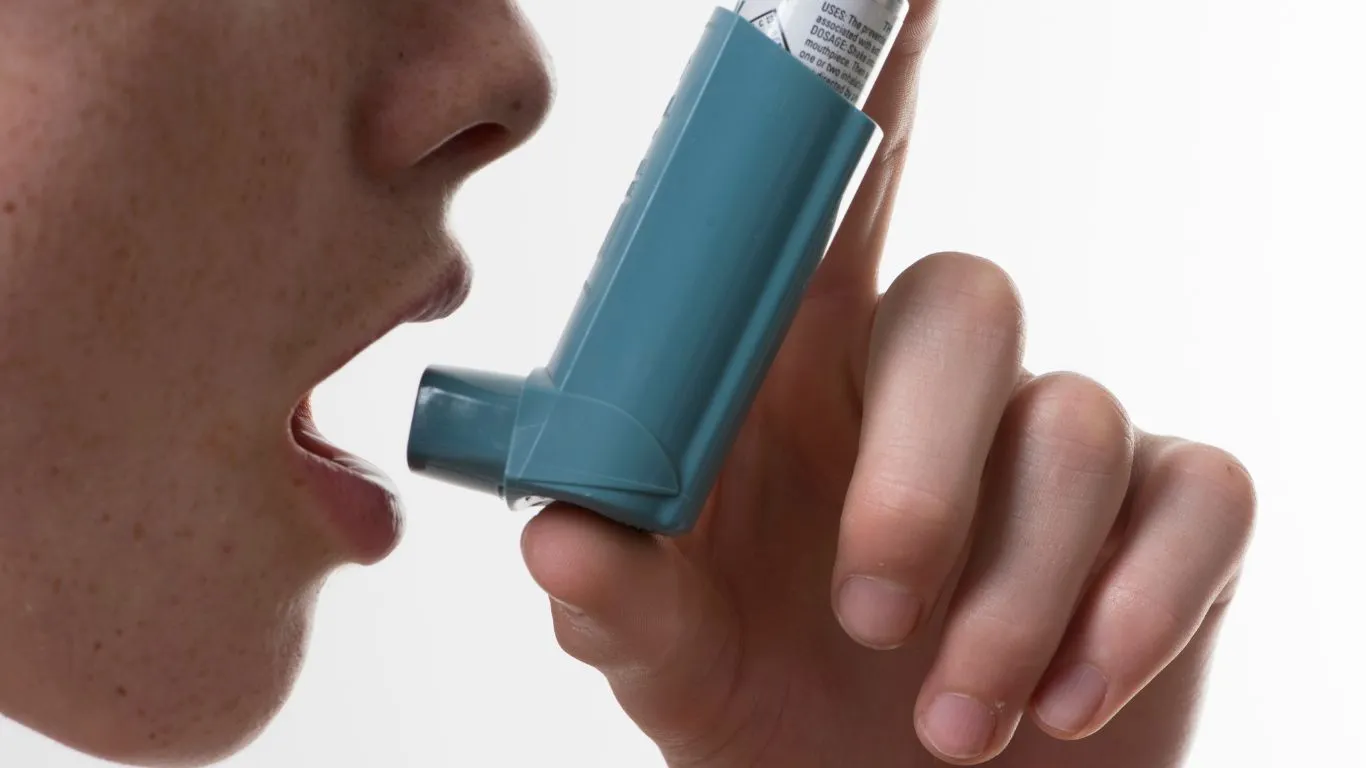Can Asthma Cause Trouble Exhaling? 5 Tips to Breathe Easier
As a Pulmonary Nurse, I’ve seen a lot of patients struggling with asthma—some with mild symptoms, others with more severe flare-ups. One question that seems to come up quite a bit is, “Can asthma cause trouble exhaling?” It’s a common concern, and rightfully so. We all know that asthma affects breathing, but it’s not always clear why it specifically makes exhaling so challenging for many people. In this article, we’ll take a closer look at how asthma impacts your lungs and why you might find it difficult to exhale, alongside some practical insights and tips from my experience working with patients in the field. Let’s dive in!
What Happens During an Asthma Attack?
Asthma attacks can be terrifying. For anyone who’s ever experienced one, you know that feeling of tightness in your chest, the inability to breathe easily, and that overwhelming panic when you just can’t catch your breath. But what’s actually happening inside your lungs during these moments? Well, asthma is a chronic condition that causes inflammation and narrowing of the airways, making it harder for air to flow freely in and out of your lungs. During an asthma attack, the muscles around your airways tighten, and the lining of your airways swells. This leads to increased mucus production, which further restricts airflow.
So, why is it harder to exhale specifically? When the airways tighten, they become narrower, making it more difficult to push air out of your lungs. You might feel as though you can inhale okay, but when it comes time to exhale, the air is trapped inside. This is why people with asthma often have a hard time getting rid of all the air from their lungs. It’s as if there’s a blockage that prevents a full exhale.
Understanding the Mechanics of Breathing
To really understand why asthma affects exhalation, it’s helpful to get a basic idea of how normal breathing works. When you breathe in, air enters through your nose or mouth, travels down your windpipe (trachea), and fills up your lungs. The oxygen in that air is absorbed by your bloodstream and carried to various parts of your body.
On the exhalation side, your lungs expel carbon dioxide, a waste product of cellular respiration, through the same pathways. Your body’s muscles, particularly the diaphragm and intercostal muscles between the ribs, help push air out. When everything is working smoothly, this process happens effortlessly. But for someone with asthma, the process isn’t so simple. The constricted airways make it harder to fully expel the air, leading to trapped air in the lungs and feelings of shortness of breath.
The Role of Inflammation in Asthma and Exhalation Difficulties

In addition to muscle tightening, asthma also causes inflammation in the airways. Think of it like the inside of your airways being lined with a thick layer of swelling and mucus. This makes it even harder for air to pass through. Now, when you try to exhale, all that inflammation can cause the airway to collapse or constrict more easily, which means it’s much harder for you to push air out of your lungs. This is a huge part of the problem when it comes to the difficulty of exhaling in asthma.
The Cycle of Air Trapping
Air trapping is something that happens frequently during an asthma attack or flare-up. Because of the narrowed and inflamed airways, the air can’t flow out as easily. The longer the air is trapped, the more difficult it becomes for the person to fully exhale, leading to a vicious cycle of breathing trouble. This is why asthma can often feel like you’re “breathing in but not breathing out”—it’s not that you’re unable to inhale, but rather that the exhale is restricted, and as a result, you might feel like you can’t get enough air.
What Causes Exhalation to be So Difficult in Asthma?

There are several factors that contribute to the difficulty in exhaling for someone with asthma. Here’s a breakdown of the primary culprits:
- Bronchoconstriction: This is when the muscles around your airways tighten, making them narrower and harder for air to pass through. This can happen suddenly during an asthma attack and can worsen exhalation difficulty.
- Inflammation and Swelling: As mentioned earlier, the lining of your airways becomes inflamed, making them more sensitive and prone to constriction. This swelling further restricts airflow.
- Increased Mucus Production: Asthma often leads to excess mucus in the airways. This mucus can block airflow, making it even harder to exhale fully.
- Airway Hyperresponsiveness: Asthma causes your airways to become overly sensitive to certain triggers like allergens, pollution, or exercise. This means that any exposure to these triggers could cause a flare-up and make it harder for you to exhale properly.
How Can You Manage Exhalation Difficulties During Asthma?

Managing asthma symptoms, especially when it comes to the difficulty of exhaling, is key to improving your quality of life. Here are some tips based on my personal experience with asthma patients:
- Use a Rescue Inhaler: This is often the first line of defense when you’re struggling with an asthma attack. A rescue inhaler (like albuterol) helps relax the muscles around the airways and opens them up, allowing you to breathe more easily.
- Control Inflammation: Long-term control medications, such as inhaled corticosteroids, can help reduce inflammation in the airways, making it easier to breathe and preventing the tightening of the muscles.
- Avoid Triggers: Try to identify and avoid asthma triggers, whether it’s smoke, dust, strong odors, or pet dander. Less exposure to triggers can reduce the frequency and severity of asthma attacks.
- Practice Breathing Exercises: Techniques like pursed-lip breathing can help slow down your exhalation and prevent air from getting trapped in your lungs. It’s a simple but effective method to manage the exhale difficulty during an attack.
- Stay Active with Care: Exercise can be beneficial for lung health, but make sure you’re monitoring your asthma symptoms closely and using preventative medications if needed before engaging in physical activity.
By actively managing your asthma, you can reduce the likelihood of experiencing difficulties with exhalation and improve your overall breathing capacity.
Why Is Exhaling So Challenging for Some Asthma Patients?
As we’ve seen, asthma is a complex condition that can make breathing in and out difficult, but it’s especially the exhalation part that tends to be the trickiest. The sensation of air being trapped in your lungs can leave you feeling anxious, and in some cases, can trigger even more respiratory issues. But why is exhaling such a challenge for some patients, even if they’re on medication or managing their condition otherwise? Well, there are a few factors to consider that might explain why the exhale is so problematic.
Exhalation vs. Inhalation in Asthma
When you think about breathing, it seems like an even process: you inhale, and you exhale. But in asthma, inhalation and exhalation aren’t always equal. During an asthma flare-up, the airways constrict, which makes it much more difficult for you to push air out of your lungs. You might find that you can inhale enough air, but when it comes time to exhale, it feels like you’re blowing out through a straw. This air trapping is the key culprit in that feeling of being unable to exhale fully.
Here’s a little analogy: imagine trying to squeeze water out of a narrow pipe that’s been clogged with debris. No matter how hard you try, the water is just stuck. In asthma, the mucus, inflammation, and bronchoconstriction create this “clogging” in your airways, making it hard to fully release the air trapped in your lungs. The process of exhalation requires the muscles to work hard to push air out, but when those muscles are working against constricted airways, it becomes a much more difficult task.
The Impact of Asthma Medications on Exhalation

Medications play a huge role in managing asthma symptoms, especially in reducing inflammation and opening up the airways. However, not all asthma medications work in the same way, and some may be more effective at improving exhalation than others. As someone who works with asthma patients regularly, I’ve seen firsthand how crucial it is to find the right treatment plan to ensure patients can breathe comfortably and exhale without restriction.
Rescue Inhalers vs. Maintenance Inhalers
Rescue inhalers (often containing bronchodilators like albuterol) are designed for quick relief during an asthma attack. They work by relaxing the muscles around the airways, opening them up so you can breathe more easily. If you’re struggling with trouble exhaling during a flare-up, a rescue inhaler can provide that much-needed break from tightness, allowing for more effective exhalation.
On the other hand, maintenance inhalers (such as corticosteroids) help reduce inflammation in the airways over time. These don’t necessarily give immediate relief, but they’re essential for controlling chronic asthma symptoms. If your airways are chronically inflamed, it can make the exhalation process much more difficult, so using a maintenance inhaler regularly can help prevent this from happening in the first place. However, even with these medications, exhalation may still be challenging during an acute asthma attack.
The Role of Allergies and Asthma in Exhalation
If you have asthma, there’s a good chance you’ve also dealt with seasonal allergies or some kind of environmental sensitivities. In fact, many people with asthma find that their exhalation problems become worse when allergens like pollen, dust, or pet dander are in the air. This is due to the fact that allergens can trigger inflammation in the airways, further constricting them and making exhalation even harder.
From my experience as a Pulmonary Nurse, managing asthma symptoms involves not just controlling the asthma itself, but also keeping allergies in check. For example, using antihistamines or allergy medications can help reduce the inflammatory response to allergens, ultimately making breathing—and more importantly, exhalation—much easier. Sometimes, just managing these allergic triggers can make a world of difference in how you breathe on a daily basis.
Environmental Triggers and Air Quality
Air quality is another important factor to consider when dealing with asthma. Poor air quality, such as exposure to smoke, pollution, or strong odors, can make exhalation even more challenging. Asthma patients often report feeling more constricted in their breathing when they’re in environments with bad air quality. The combination of pollutants and irritants can worsen inflammation and cause the airways to tighten, creating more difficulty with exhalation.
If you live in an area with frequent pollution or if you’re often exposed to secondhand smoke, it’s essential to take extra precautions, such as using air purifiers in your home or avoiding outdoor activities when pollution levels are high. Being mindful of your environment can help prevent exhalation issues from worsening over time.
Breathing Exercises to Improve Exhalation

When it comes to managing asthma symptoms, one of the most effective ways to improve exhalation is through specific breathing exercises. These exercises help strengthen the muscles used in breathing and can provide relief from the feeling of trapped air. They can also teach you how to regulate your breathing during an asthma flare-up, which makes it easier to exhale fully.
Pursed-Lip Breathing
One of the simplest and most commonly recommended breathing techniques for people with asthma is pursed-lip breathing. This technique involves breathing in slowly through your nose and exhaling through pursed lips (as if you’re blowing through a straw). The purpose of this technique is to keep the airways open longer, allowing more time for air to flow out of the lungs and reducing the feeling of air trapping.
In my experience, patients who regularly practice pursed-lip breathing during an asthma attack report feeling less anxiety and are able to exhale more effectively. It’s an easy, non-invasive technique that can be done anywhere, making it a useful tool for asthma management.
Diaphragmatic Breathing
Diaphragmatic breathing, also known as “belly breathing,” involves engaging your diaphragm to help push air out of your lungs more efficiently. By using your diaphragm, you help regulate the pressure within your lungs, which can make it easier to fully exhale, even when your airways are narrowed. For many asthma patients, this technique can reduce the work required to breathe and minimize the sensation of air being trapped.
When Should You Seek Immediate Medical Attention?

While asthma is manageable for most people, there are times when exhalation difficulties can signal a more serious issue. If you’re struggling to exhale and not responding to your usual medications, it’s important to seek medical attention right away. Signs that you should seek immediate help include:
- Severe difficulty breathing that doesn’t improve with a rescue inhaler
- Chest tightness that feels like you can’t take a full breath
- Blue lips or face due to lack of oxygen
- Confusion or dizziness from oxygen deprivation
These symptoms may indicate a more severe asthma attack or a complication, such as an asthma exacerbation, and prompt treatment can prevent further complications.
Living with Asthma: Tips for Improving Exhalation and Overall Breathing
As we’ve explored in the previous sections, exhaling can be a real challenge for people with asthma, but the good news is that there are many strategies you can use to make breathing easier. From using the right medications to incorporating breathing exercises into your routine, managing asthma can significantly reduce the difficulty of exhaling and improve your overall quality of life. I’ve worked with countless patients who, with the right approach, have learned to manage their asthma symptoms effectively and breathe much easier, even during flare-ups.
Stay on Top of Your Asthma Action Plan
One of the most important things you can do as an asthma patient is to work closely with your healthcare provider to develop a personalized asthma action plan. This plan outlines exactly what steps you should take depending on your symptoms, whether you’re experiencing mild, moderate, or severe asthma issues. By following your action plan, you’re not just addressing your symptoms but also taking proactive steps to prevent exhalation difficulties from escalating into something more serious.
As a nurse, I’ve seen time and time again how having a clear, actionable plan can help patients stay ahead of asthma flare-ups. Knowing when to take your medication, when to use your inhaler, and when to seek medical attention can make a huge difference in your ability to breathe comfortably.
Building Your Asthma Support System

Managing asthma can feel like a daunting task, but it doesn’t have to be something you do alone. Building a strong support system—whether it’s with your family, friends, or healthcare providers—can significantly improve how you handle symptoms, especially when exhalation difficulties arise.
From my experience working with patients, having a trusted support network can help you stay motivated and calm during tough times. Asthma can be unpredictable, so it’s important to have someone who understands your condition and knows what to do in case of an emergency. This might include making sure you have access to your medications, knowing how to use them correctly, or simply offering emotional support during an attack.
Your healthcare team should also be a part of this support system. Regular check-ups with your doctor and open communication with your nurse or pulmonologist can help ensure that your asthma is under control and that your medications are working as they should. If you notice that exhalation difficulties are becoming more frequent or severe, it’s crucial to discuss this with your doctor so they can adjust your treatment plan accordingly.
Healthy Lifestyle Choices That Support Asthma Management
In addition to medications and breathing exercises, making some lifestyle changes can go a long way in reducing the impact asthma has on your ability to exhale and breathe comfortably. These changes are often about reducing inflammation in the body and minimizing asthma triggers, and they don’t have to be overwhelming to implement.
Stay Active—But Know Your Limits
Exercise is essential for lung health, but it’s important to approach physical activity with caution if you have asthma. Strenuous exercise can trigger asthma symptoms, including difficulty exhaling, but with the right precautions, staying active can improve your overall respiratory function.
In my experience, I’ve seen patients who are able to maintain an active lifestyle by adjusting their routines. For example, instead of running outside on a cold, dry day, you might choose to swim indoors, as the warm, humid air is gentler on the lungs. Or you could consider low-impact activities like yoga, which not only helps with physical fitness but also improves your breath control and relaxation.
It’s also crucial to warm up before any exercise and cool down afterward, as this can help prevent sudden breathing difficulties. And if you do plan to exercise, make sure you use your inhaler as directed by your doctor and always have it on hand in case of an emergency.
Eat a Healthy, Anti-Inflammatory Diet
What you eat can have a significant impact on your asthma symptoms. A diet rich in anti-inflammatory foods—such as fruits, vegetables, whole grains, and omega-3 fatty acids—can help reduce airway inflammation and make it easier to breathe. Foods like fish, nuts, and leafy greens have anti-inflammatory properties that support overall lung health.
On the other hand, it’s best to avoid processed foods, sugary snacks, and excessive dairy, as they can contribute to inflammation and mucus production. If you have food allergies or sensitivities that exacerbate your asthma, it’s crucial to eliminate those triggers from your diet to keep your symptoms under control.
As part of a holistic approach, I’ve had patients share how making small, mindful dietary changes not only improved their energy levels but also made it easier for them to breathe deeply without that feeling of air being trapped in their lungs.
When to See a Doctor for Asthma Management
Even with the best self-management strategies, there may be times when your asthma symptoms become unmanageable. If you find that you’re having trouble exhaling frequently, or if your rescue inhaler isn’t providing the relief it once did, it’s important to seek medical attention. Asthma can change over time, and it’s essential to stay in touch with your healthcare provider to make sure your treatment plan is still working for you.
As a nurse, one of the most common pieces of advice I give patients is to never wait too long before seeking help. It’s much easier to manage symptoms when you catch them early, before they become a full-blown emergency. If your breathing becomes more labored or you notice other troubling symptoms (like wheezing, coughing, or chest tightness), it’s time to schedule an appointment with your doctor to reassess your asthma control.
References
Disclaimer
The information provided in this article is for educational purposes only and should not be considered as medical advice. Always consult with a healthcare professional before making any changes to your asthma management plan or starting new treatments. The author is a trained Pulmonary Nurse, but individual experiences may vary. If you or someone you know is experiencing severe asthma symptoms, please seek immediate medical attention.

Bianca Nala is a compassionate Nurse Practitioner with a strong background in primary and respiratory care. As a health writer for Healthusias.com, she combines her clinical expertise with a talent for clear, relatable storytelling to help readers better understand their health. Bianca focuses on topics like asthma, COPD, chronic cough, and overall lung health, aiming to simplify complex medical topics without losing accuracy. Whether she’s treating patients or writing articles, Bianca is driven by a single goal: making quality healthcare knowledge accessible to everyone.






